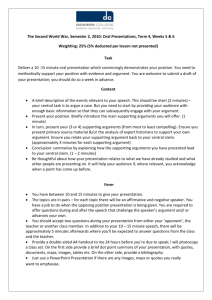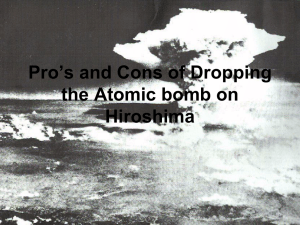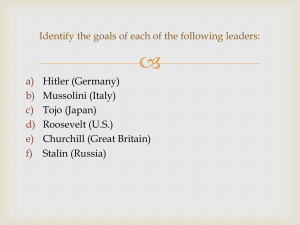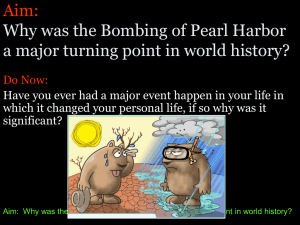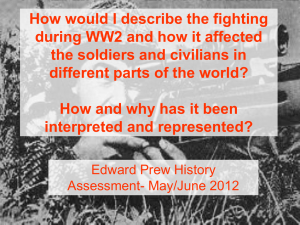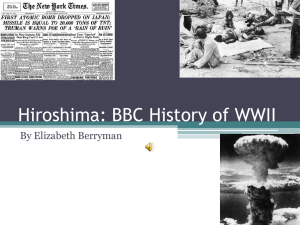How Destructive was WW2? - Beverley Grammar School
advertisement
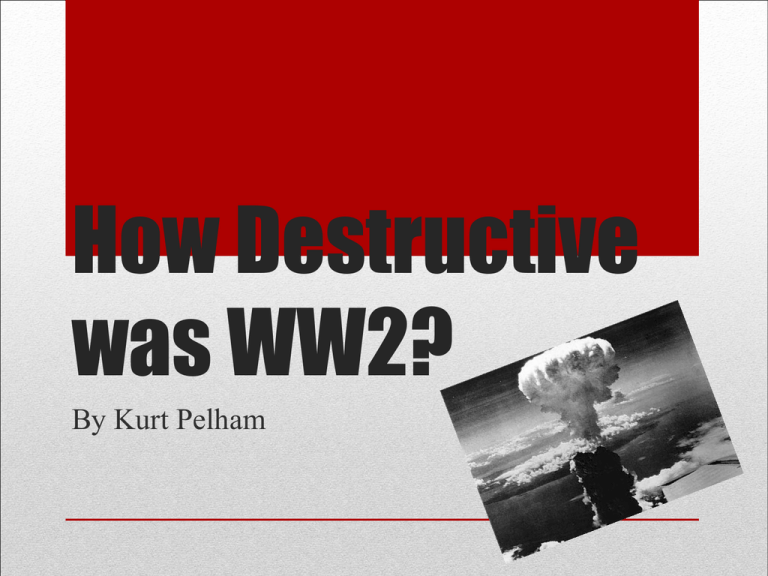
How Destructive was WW2? By Kurt Pelham World War Two was the most destructive war ever in human history, with a total number of 60 million deaths. These heavy loses did not just come from guns or the ordinary tank, weaponry by then had advanced greatly and other things such as artillery and bombing, which had become much more accurate. Tanks had became faster and lighter which made it easy for the troops to maneuverer them, new planes were introduced such as the spitfire which was very fast and again easier to maneuverer. New explosives and bombs were used which made it much easier for soldiers to clear bunkers. The most destructive bomb and weapon in World War 2 was the Nuclear Bomb. Bombing Bombing was a huge part of the war, and the most destructive. It killed millions of people due to the raging flames, explosions and the thick smoke which would have suffocated people as there was no oxygen to breathe. Over 700,000 bombs were dropped during the war and 3.4 million tonnes of them were dropped by the Allies between 1939 and 1945. Here are some images of the planes that the bombs would have been dropped by. London Bombing On 7th September 1941, Hitler had sent German bombers over to Britain and to destroy cities, industries, factories, and more importantly, the populations morale. London was the most badly hit as many famous buildings were hit or destroyed, such as the Law Courts, the Tower of London, House of Commons, West Minster Abbey, Buckingham Palace, St Pauls Cathedral and many more. The Bombing lasted for 57 consecutive days. This started to become normal for the civilians as they just went through it. This started to show failure in Hitler's plan to lower morale, as people kept there mental toughness. However, people were being thrown across the roads from the huge blasts. 40,000 people died from this attack. Britain Bombing 30,000 bombs were dropped on Britain leading to a massacre with bodies, limbs, and flesh mingled with little hats, coats and shoes. There were many major historic places that were bombed and probably destroyed. Shops, roads and buildings were bombed, also some of the countries water, sewage, gas and electricity would have also been destroyed. This would have been bad as people would have had nothing to put the fires out with. Despite all this, there was a sense of excitement in the shelters as people were telling jokes and singing to keep their morale up. Some people were wanting to fight back which also showed Hitler’s intensions had failed. There many religious ways of keeping there morale up, as some thought that it would be safer in the churches with God. Germany Bombing The bombing of Germany was one of the worst. More bombs were dropped on one city than the entire bombing of Britain. 50,000 bombs were dropped in three days which killed 50,000 civilians. People were burning and suffocating to death as the temperatures were at a high of 1000 degrees. People could not find members of their family as they were burnt to death which made them unrecognizable. Many industries were bombed which damaged the amount of weaponry and resources for the German army. Civilians morale was decreasing as every time they saw a person wearing a Nazi party badge, they tore them off and started screaming an saying “Lets go and get that murderer!” On the other hand, some of the people were growing toughness as they would have wanted revenge for they had done. Japan Bombing Japan was one of the worst hit along with Germany. The first bombing killed 100,000 people in Tokyo, and over 120,000 people died while a million fled to safety in the countryside. The temperatures were so hot, that if a person jumped into the rivers they would boil to death. Huge amounts of buildings were blown up, and 20% of Tokyo’s war industries and 60% of its business district was completely destroyed by the bombers. Nuclear Bomb on Hiroshima and Nagasaki The Atomic bomb was the most devastating and destructive attack ever made. When the war was coming to an end in 1945 after Nazi Germany signed its instrument of surrender, the United States called for a surrender of Japan in the Potsdam Declaration on 26 July 1945, threatening Japan with "prompt and utter destruction". Japan ignored this so America deployed two nuclear bombs on the cities of Hiroshima and Nagasaki. After the bomb had hit it was recorded that the effects had killed 90,000-166,000 in Hiroshima and 60,000-80,000 in Nagasaki. Six days after the bombing on the 15th August, Japan announced its surrender to the Allies. Pictures from after the Nuclear Bomb on Hiroshima and Nagasaki World War 2 affected many in different ways, such as Psychologically, Socially and Economically, Physically and Politically. One of the main intensions of bombing innocent civilians was to lower the morale to cause conflict within its own country about whether they should stop fighting and to surrender or not. Many people reacted in different ways to this. Some chose to keep their morale and pride up by singing and joking and some grew toughness and determination for revenge, whereas others started to blame their own soldiers and leaders for starting the war in the first place. Religion came into the matter where people went into churches because they knew that God would protect them. This however may have put some peoples morale down, as they may have witnessed bombing of churches which would put doubt in their minds that God doesn’t exist.

